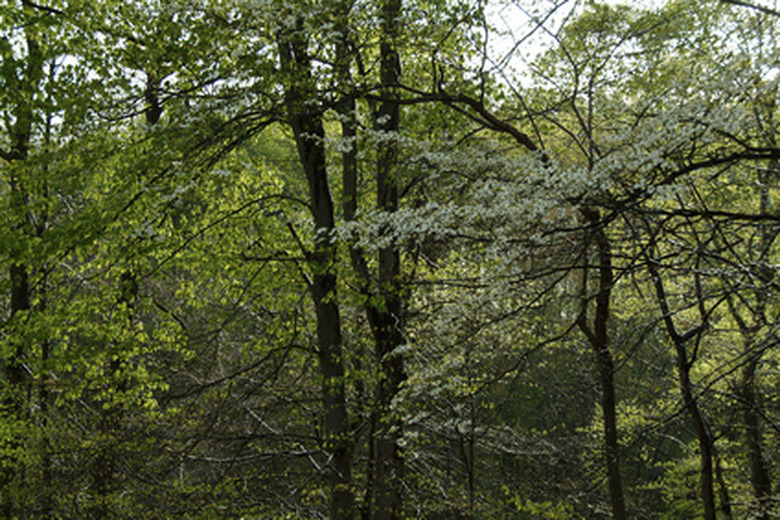How Tall Do Dogwood Trees Get?
Determining how tall dogwood trees grow depends on which species you choose to grow. Environmental conditions affect ultimate tree height, and different trees grow at varying paces. Familiarize yourself with different types of dogwood trees, their particular features and individual height expectancies when making your selection for the home garden.
Dogwood Description
Dogwood trees are flowering trees that reach a height range of 15 to 40 feet. When grown in the sun, these deciduous trees reach a height of 15 to 20 feet, but when grown in the shade, they grow up to 40 feet. Tree width equals or exceeds the height. Some dogwoods yield showy flowers, while other dogwoods produce tiny clusters of flowers during the end of the winter season and the beginning of spring, according to the Clemson University Extension. What most people think are flowers are actually bracts or modified leaf structures that resemble flower petals. The tiny clusters within these structures are the actual flowers of the dogwood tree. Bracts appear in yellow, pink or white hues. Growth rate of the dogwood tree is considered slow to moderate, averaging 20 feet of new growth every 25 years.
- Determining how tall dogwood trees grow depends on which species you choose to grow.
- Growth rate of the dogwood tree is considered slow to moderate, averaging 20 feet of new growth every 25 years.
Kousa Dogwood
Kousa dogwood trees (C. kousa) grow to a height and width of 20 to 25 feet, according to the Clemson University Extension. This dogwood species displays bracts and flowers in the spring in colors of cream/white that may become pink as trees become established. Green leaves turn purple, red or yellow during autumn. The kousa dogwood's growth rate is approximately 10 feet in 15 years.
Flowering Dogwood
Flowering dogwoods (C. florida) grow to a height of 40 feet in shaded conditions or 15 to 20 feet in full sun exposure, according to the Clemson University Extension. Flowering dogwoods display showy bracts during April and May in red, white or pink. Green leaves change to red or red-purple during the autumn. This species grows 15 feet within 18 years but has exhibited a faster growth rate when grown in the shade. The flowering dogwood is highly susceptible to fungal infections and dogwood borer pests. Avoid waterlogged soil with this species, because wet conditions are ideal for fungal growth.
- Kousa dogwood trees (C. kousa) grow to a height and width of 20 to 25 feet, according to the Clemson University Extension.
- This dogwood species displays bracts and flowers in the spring in colors of cream/white that may become pink as trees become established.
Cornelian Cherry Dogwood
Cornelian cherry dogwood trees (C. mas) grow to a height of 20 to 25 feet with a width of 15 to 20 feet, according to the Clemson University Extension. This species displays showy flowers during the end of winter and beginning of spring. Flowers are showy and yellow. Green leaves become purple-red to a desaturated green during autumn, but color is often lackluster. Cornelian cherry dogwoods are known for their resistance to pests as well as dogwood anthracnose disease.
Care and Use
For successful growth of dogwoods to their full height potential, proper care is essential. Provide partial shade when possible; dogwoods will grow in full sun but may develop into a shorter plant. Plant dogwoods in acid, moist, well-drained soil with a pH of 5.5. to 6.0. Amend soil with organic content like compost if drainage is poor. Add up to 3 inches of mulch around the tree without allowing contact with the tree trunk for water retention, according to the Clemson University Extension. Water weekly at a rate of 1 to 2 inches if your tree is exposed to full sun. All dogwood trees are well-suited for use in borders, as specimen plants or as a component of a natural screen.
- Cornelian cherry dogwood trees (C. mas) grow to a height of 20 to 25 feet with a width of 15 to 20 feet, according to the Clemson University Extension.
- Provide partial shade when possible; dogwoods will grow in full sun but may develop into a shorter plant.
